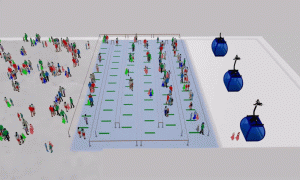By Erin Clark, Vice President
Wayfinding is the process of using visual cues, landmarks, and other spatial information to help guests navigate a destination. Simulation technology provides a powerful tool for enhancing wayfinding and placemaking design, allowing designers to test how people will explore and navigate environments.
Agent-based modeling involves creating a virtual environment populated by individual agents (people) that interact with each other and their environment. Each agent is given a set of rules that govern its behavior, and by simulating the actions of all the agents over time, you can observe the emergent behavior of the system as a whole. Researchers and designers can use this technique to accurately simulate the flow of people.
Here Are Four Ways Simulation Technology Can Be Used to Enhance Wayfinding Design:
1. Provide Flexibility in Understanding People Flow
The first step in using simulation to address an opportunity with people flow is to gather information on the layout/measurements of the physical space, the number of customers expected on a designated day, their arrival curves, and any restrictions or limitations that may impact guest flow. Using this data, a simulation model can be built that accurately represents the physical space and the flow of customers through it. The simulation is then able to generate realistic scenarios based on different inputs, such as varying the number of individual agents or adjusting the placement of certain attractions.
Once the simulation is complete, users can analyze the results to gain insights into how people move through the environment. Researchers can also experiment with different scenarios, such as adding or removing obstacles or changing the behavior of agents, to see how this affects the flow of people.
2. Determine Customer Decision Points En Route to Their Destination
In a wayfinding simulation, individuals are represented as agents that move through a virtual environment and make decisions based on various factors such as visual cues, landmarks, signage, and their own personal preferences.
Simulations can be programmed with algorithms that mimic human behavior and decision-making processes, allowing industrial engineers to observe how people might navigate through an environment in different scenarios. By analyzing the simulation output, researchers can gain insights into the factors that influence wayfinding decisions, including when, where, and how people respond to different stimuli and environmental conditions.
For example, a simulation can be used to predict the decision points an airport passenger might encounter en route to their gate. By modeling human behavior, researchers can observe patterns and trends in decisions that individuals make and use this information to inform the design of the physical environment and signage.
The video below shows how Integrated Insight simulated guests’ decision-making for an immersive entertainment venue that was interested in better understanding its capacity. Uniquely tailored personas dictated how and where agents moved about within the venue.
3. Identify Bottlenecks and Congestion
Simulation can be a useful tool in alleviating congestion and bottlenecks because it allows designers to test and evaluate different strategies and interventions in a controlled and safe environment before implementing them in the real world.
For example, simulation can be used to create virtual models of crowded spaces, such as airports or train stations, and test different scenarios, such as changing the location of certain facilities, modifying the flow of foot traffic, or adjusting the timing of events. By doing so, planners can identify potential problems or bottlenecks in the system and develop effective solutions to alleviate congestion.
Simulation can also help identify potential safety hazards and evaluate the effectiveness of emergency response plans in crowded environments. By simulating emergency situations, planners can determine the best evacuation routes, assess the effectiveness of emergency communication systems, and identify areas that may require additional safety measures.
The agent-based simulation below modeled the rapid exit by venue guests to test the operation’s ability to handle emergencies. Based on guest service standards developed in conjunction with the client, Integrated Insight was able to simulate where bottlenecks would occur and when wait times would fail to meet those standards. You can see the agents interacting with each other and building congestion as they evacuate the theatre.
4. Visualize the Impact of Changes in Signage and Physical Layout
Simulation can be a powerful tool for improving wayfinding, especially in complex or unfamiliar environments. By creating a digital model of the environment, designers can simulate how people will move through it and identify potential issues with wayfinding, such as confusing signage or unclear paths. They can then make adjustments to the design to improve wayfinding before construction begins.
Once a physical environment has been built, simulation can be used to evaluate the effectiveness of different wayfinding strategies. By tracking the movements of people through the environment, designers can identify areas where people are getting lost, experiencing confusion, or becoming bottlenecked. They can then experiment with different signage, lighting, or other wayfinding cues to see which strategies are most effective.
Simulation is especially beneficial when theorizing how a small adjustment in signage, such as a change in color, size, or location, affects how an individual navigates through a venue. By simulating different conditions, changes in signage can be measured by the flow of the agents. Similarly, simulation can help designers visualize how a major layout reconfiguration affects how a group of people, or a full day of guests, reacts to the new environment. Visualizing such changes in a virtual world first can help businesses save time, aid in capacity planning, and reduce costly post-construction improvements.
Leverage Agent-Based Simulation in Your Next Design
Overall, simulation provides architects, designers, and key stakeholders with a powerful tool to test and refine wayfinding designs, which results in an improved user experience and optimized design.
For more information on simulation and how we partner with businesses across the globe to improve operational efficiency, please contact us at info@integratedinsight.com.
Read More Insights
Agent-Based Simulation in the Themed Entertainment Industry: Enhancing the Guest Experience with Predictive Analytics
Simulation and AI technology enable designers to test experiential designs, improve operational efficiency, and ensure health and safety protocols.
Read MoreIdentifying Safe Reopening Strategies for Ski Resorts Using Agent-Based Simulation
Agent-based simulation can model operational scenarios to aid in decision making, including line management techniques.
Read MoreOptimizing Restaurant Space To Increase Sales During COVID-19
With capacity constraints and space limitations, restaurants need to optimize the utilization of space available to increase daily sales.
Read MoreHow Can We Help?
Schedule a free consultation to discuss your business needs.








